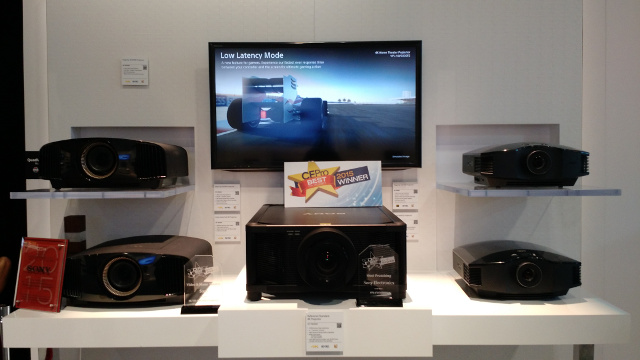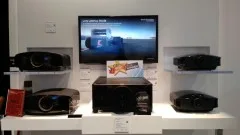The Sony brand is alive and well in the custom install market. At Cedia 2015, the company announced that sales, primarily projectors, were up 63% compared to a year ago. Sales of Sony’s 4K projectors is propelling this momentum. Introduced in 2012, Sony claims they now hold an 80% market share for 4K projectors in the Cedia channel. That’s impressive and at Cedia they announced the new line for 2016.
There are four models for 2016, with three offering native 4K resolution panels featuring Sony’s SXRD LCOS technology. There are three lamp-based models that offer an impressive 6,000 hour lifetime. All include Sony’s advance reality creation engine for scaling and control capability for major control providers.
At the entry level is a 1080p model, the VPL-HW65ES, which will be available in October for $3,999. It offers 1800 lumens of brightness and 120,000:1 of dynamic contrast using an iris. Sony does not specify the static contrast of the projector. This projector features IP control and is also 3D capable using RF synchronization.
The entry level 4K projector is the VPL-VW365ES coming in October will be offered at $9,999. This features 1500 lumens of output and 30,000:1 of dynamic contrast using an iris. It includes Sony’s Triluminos engine for improved color reproduction and Motionflow picture technology for less blurry images when watching fast-paced, sports action.
The step-up VPL-VW665ES, available in October for $14,999, has all the same features as the 356ES but offers 1800 lumens of light and 300,000:1 of dynamic contrast using an iris. The above three lamp-based projectors have a new lamp with a very impressive 6,000 hour to 50% luminance lifetime rating.
The flagship is the VPL-VW5000, which will be available in 2016 at $59,999. This is a laser-phosphor model offering 20K hours of source lifetime in normal mode (to 50% brightness?) and twice that in eco mode. There is periodic calibration to automatically adjust the color levels as the light source changes over time and fan noise is very low at less than 35 dB; 32 dB in low brightness mode. Dynamic contrast is speced at infinite as Sony can modulate the laser output down to zero for extremely low black levels.
Last year’s VW1100 continues with an MSRP of $28K.

Most importantly, all three of the 4K projectors are now HDR enabled. What that means for Sony is that the projectors can playback content using the PQ gamma curve, will recognize 2020 encoded colors and map to the capabilities of the projector and it can recognized and act on static metadata in the HDR video stream. Plus, the projector must support HDMI 2.0a interface for delivery of the HDR signaling and 4K at 60 fps. HDCP 2.2 is also enabled.
Supporting HDR in a projector requires a high native contrast level. Unfortunately, Sony does not spec the native contrast – only the projector’s dynamic contrast using an iris. This is helpful for moving the dynamic range of the projector based on the average content luminance, but it does not extend the contrast. JVC specs both the native and dynamic contrast using the iris. There is a 10x difference between the two specs with JVC so maybe Sony’s difference is similar.
In terms of color space, Sony is claiming that all the 4K projectors can display the P3 DCI color gamut when a yellow notch filter is mechanically inserted in the light path (Cinema 2 mode). This, and calibration, will reduce the overall luminance of the projectors.
In the prepared demo that Sony showed in their theater, they showed a variety of content coming from Dish using four Dish receivers and switched by an RGB Spectrum device. Sound supporting Atmos and DTS-X immersive standards was provided using the new Sony STR-ZA5000ES AV Receiver. Content consisted of two 1080p and two 4K resolution pieces. At 1080p, the projector upscaled to 4K and played a musical clip with spatial patterns based on the notes or sounds, followed by a clip from Game of Thrones. The first 4K piece was from Blacklist and the second was in HDR from one of the Spiderman movies. The content looked quite good, but there was not as much “pop” in the HDR content as I was hoping for. It may have been the content selection.
Outside the booth, Sony was showing SDR vs. HDR on their TV sets running a Carnival clip. That had a lot of “pop” and Sony offered to try to show this on the projector, but was unable to for several reasons, although they said it looked similar on the projector. – CC

